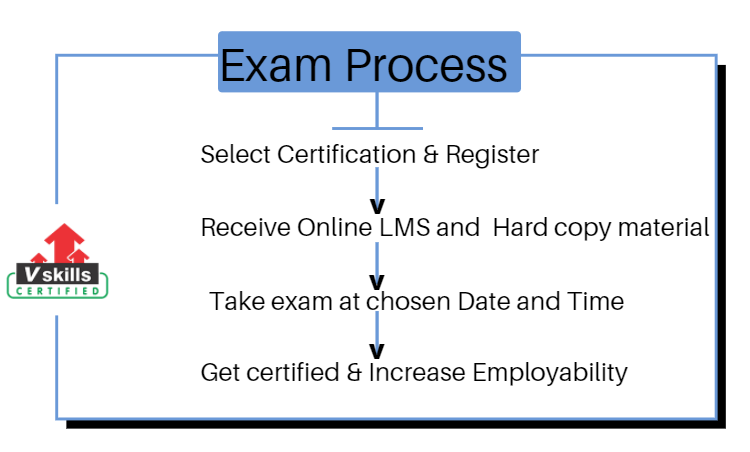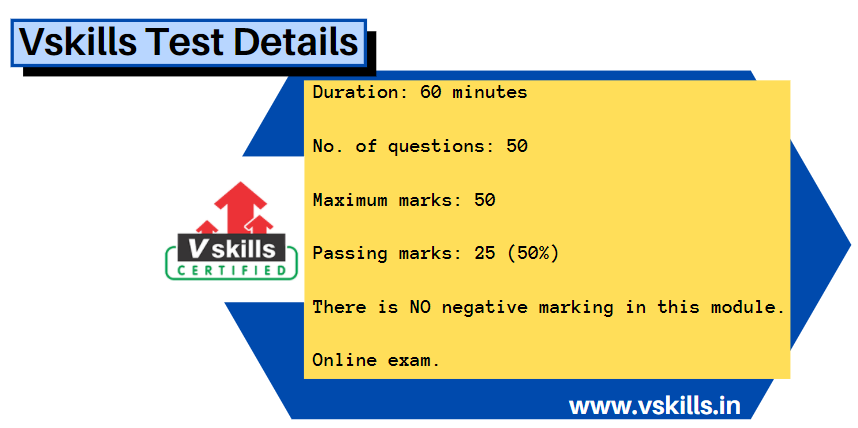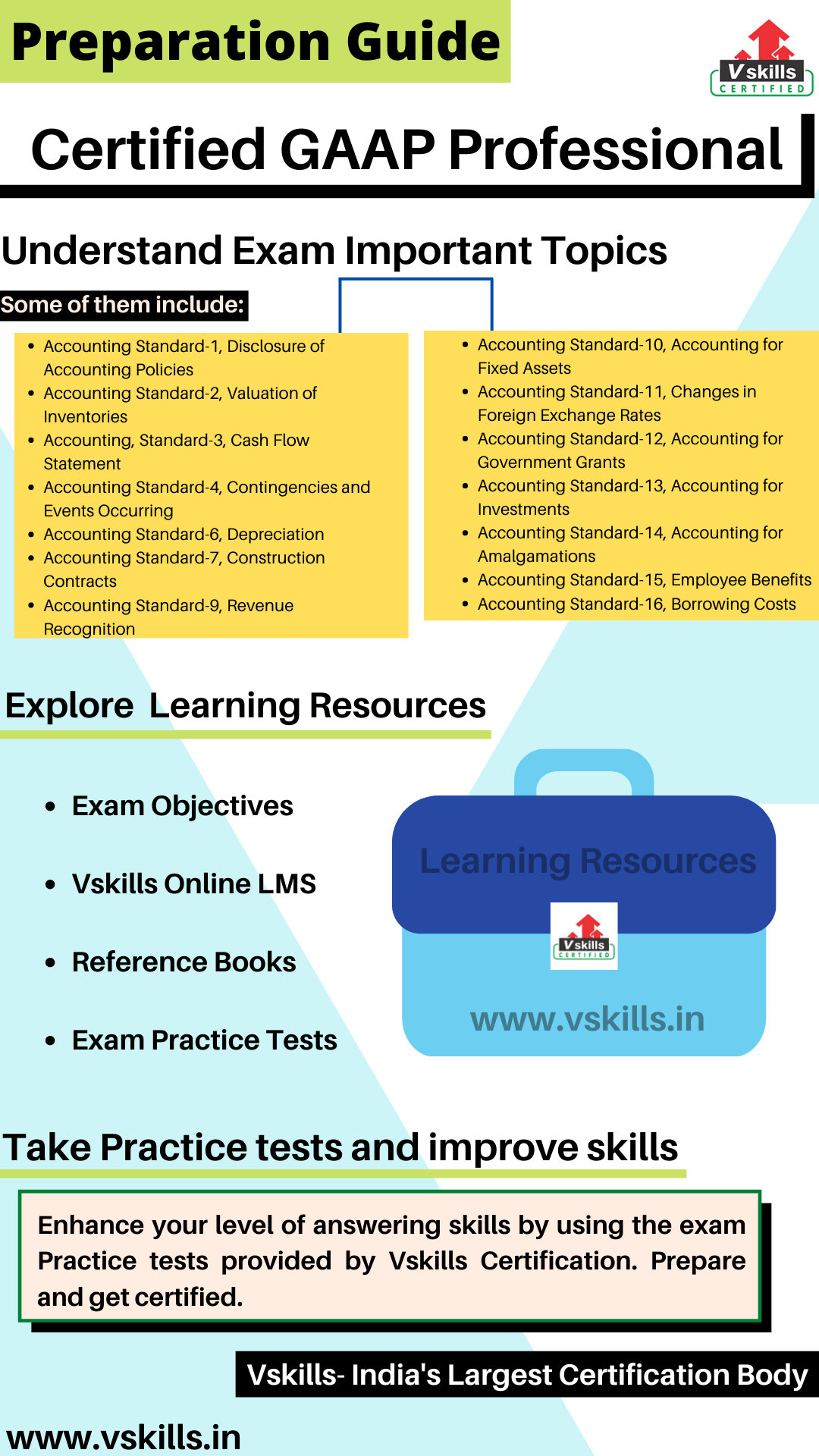
GAAP Professionals are responsible for governing the world of accounting according to general rules and guidelines. That is to say, it attempts to standardize and regulate the definitions, assumptions, and methods used in accounting across all industries. However, the main motive of GAAP is to ensure a company’s financial statements are complete, consistent, and comparable.
Role of GAAP
- GAAP Professionals helps businesses to maintain consistency in their appearance of financial information.
- It also helps an organization to figure out whether it is making money or not. Moreover, it makes decisions about cash flow.
- GAAP also offers the chance to compare the financial status of the business with similar types of companies.
- Lastly, GAAP guidelines give assurance that the financial statements were prepared using without fraudulent.
Vskills Certified GAAP Professional: Overview
Vskills GAAP Professional certification examines the candidate according to the latest company’s need for compliance with GAAP. Moreover, the certification validates the candidates in various areas. This includes balance sheet presentation, balance sheet presentation, financial instruments, GN (A)-18, and various accounting standards from AS-1 to 7 and AS-9 to 29. Talking about the course, this course is designed for professionals and graduates who want to excel in their chosen areas.
Certification Benefits
Candidates on earning Vskills GAAP Professional Certification will get advantages in today’s competitive job market. As this will increase their chances to get better job opportunities by showcasing their advanced skills, and result in higher earning potential.
The best thing about getting this certification is that GAAP Professionals are in great demand in companies specializing in finance, compliance, or consulting.

Vskills being India’s largest certification providers gives candidates access to top exams as well as provides after exam benefits. This includes:
- The certifications will have a Government verification tag.
- The Certification is valid for life.
- Candidates will get lifelong e-learning access.
- Access to free Practice Tests.
- Candidates will get tagged as ‘Vskills Certified’ On Monsterindia.com and ‘Vskills Certified’ On Shine Shine.com.

Course Outline for Certified GAAP Professional
Certified GAAP Professional covers the following topics –
1. The Conceptual Framework
1.1. Objectives of Financial Reporting
1.2. Characteristics and Limitations of a Financial Report
2. Accounting Standard-1, Disclosure of Accounting Policies
2.1. Indian GAAP on Disclosure of Accounting Policies
3. Accounting Standard-2, Valuation of Inventories
4. Accounting, Standard-3, Cash Flow Statement
4.1. Objective
4.2. Presentation of a Cash Flow Statement
5. Accounting Standard-4, Contingencies and Events Occurring
5.1. Accounting for Events Occurring After the Balance Sheet Date Under AS-4
5.2. Disclosure
6. Accounting Standard-5, Net Profit or Loss for the Period
6.1. Presentation of Income Statement under AS-5
7. Accounting Standard-6, Depreciation
7.1. Accounting for Depreciation Under AS-6
7.2. Depreciation
7.3. Methods of Depreciation
7.4. Change in Method of Depreciation
8. Accounting Standard-7, Construction Contracts
8.1. Accounting for Construction Contracts under AS-7
8.2. Terms Used in AS-7
8.3. Combining and Segmenting Construction Contracts
8.4. Contract Revenue
8.5. Contract Costs
8.6. Recognition of Contract Revenue and Expenses
9. Accounting Standard-9, Revenue Recognition
9.1. Accounting for Revenue under AS-9
9.2. Sale of Goods
9.3. Interest, Royalties and Dividends
9.4. Effect of Uncertainties on Revenue Recognition
9.5. Disclosure
10. Accounting Standard-10, Accounting for Fixed Assets
10.1. Identifying Fixed Assets
10.2. Components of Cost
10.3. Self-constructed Fixed Assets
10.4. Non-monetary Consideration
10.5. Improvements and Repairs
10.6. Retirements and Disposals (derecognition)
10.7. Hire Purchases
10.8. Joint Ownership
10.9. Goodwill
10.10. Disclosure
11. Accounting Standard-11, Changes in Foreign Exchange Rates
11.1. AS-11
11.2. Classification of Foreign Operations as Integral or Non-integral
11.3. Change in the Classification of a Foreign Operation
11.4. Disclosure
12. Accounting Standard-12, Accounting for Government Grants
12.1. Accounting for Government Grants Under the Indian GAAP (AS-12)
12.2. Accounting Treatment of Government Grants
12.3. Recognition of Government Grants
12.4. Non-monetary Government Grants
12.5. Presentation of Grants Related to Revenue
12.6. Presentation of Grants of the nature of Promoters’ contribution
12.7. Refund of Government Grants
12.8. Disclosure
13. Accounting Standard-13, Accounting for Investments
13.1. Accounting for Investments under Indian GAAP
13.2. Forms of Investments
13.3. Cost of Investments
13.4. Investment Properties
13.5. Disposal of Investments
14. Accounting Standard-14, Accounting for Amalgamations
14.1. Accounting for Amalgamation under the Indian GAAP (AS-14)
14.2. Types of Amalgamations
14.3. Methods of Accounting for Amalgamations
14.4. Treatment of Reserves of the Transferor Company on Amalgamation
14.5. Disclosures
15. Accounting Standard-15, Employee Benefits
15.1. Accounting for Employee Benefits
15.2. Short-term Employee Benefits
15.3. Termination Benefits
15.4. Accounting Treatment
15.5. Disclosures
16. Accounting Standard-16, Borrowing Costs
16.1. Accounting for Borrowing Cost in AS-16
16.2. Borrowing Costs
16.3. A Qualifying Asset
16.4. Borrowing Costs Eligible for Capitalisation
16.5. Commencement of Capitalisation
16.6. Disclosure
17. Accounting Standard-17, Segment Reporting
17.1. Segment Reporting Under AS-17
17.2. Accounting Standards Interpretation (ASI 22)
17.3. Allocation
17.4. Primary and Secondary Segment Reporting Formats
17.5. Matrix Presentation
17.6. Business and Geographical Segments
17.7. Identifying Reportable Segments (Quantitative Thresholds)
17.8. Segment Accounting Policies
17.9. Primary Reporting Format
17.10. Secondary Segment Information
17.11. Disclosures
18. Accounting Standard-18, Related Party Disclosures
18.1. Related Party Disclosures
18.2. Accounting Standards Interpretation (ASI)21
18.3. The Related Party Issue
18.4. Disclosure
19. Accounting Standard-19, Accounting for Leases
19.1. Accounting for Lease
19.2. Classification of Leases
19.3. Leases in the Financial Statements of Lessees
19.4. Leases in the Financial Statements of Lessors
19.5. Sale and Leaseback Transactions
20. Accounting Standard-20, Earnings Per Share
20.1. Presentation and Calculation of EPS
20.2. Basic Earnings per Share
20.3. Diluted Earnings Per Share
20.4. Presentation
21. Accounting Standard-21, Consolidated Financial Statements
21.1. Consolidation Principles under AS-21
21.2. Circumstances for Consolidated Financial Statements
21.3. Loss of Control
21.4. Consolidation Procedures
21.5. Cost of Control
21.6. Minority Interest
21.7. Other Points
21.8. Disposal of Holding
21.9. Disclosure
22. Accounting Standard-22 Accounting for Taxes on Income
22.1. Income Taxes Under AS-22
22.2. Recognition
22.3. Measurement
22.4. Review of Deferred Tax Assets
22.5. Disclosure
22.6. Relevant Accounting Standards Interpretations
23. Accounting Standard-23, Accounting for Investments in Associates in Consolidated
23.1. Accounting for Investment in Associates
23.2. Associates Accounted for Using the Equity Method
23.3. Contingencies
23.4. Disclosure
23.5. Relevant Accounting Standards Interpretations
24. Accounting Standard-24, Discounting Operations
24.1. Accounting for Discontinuing Operations under AS-24
24.2. Discontinuing Operation
24.3. Initial Disclosure Event
24.4. Recognition and Measurement
25. Accounting Standard-25, Interim Financial Reporting
25.1. Interim Financial Reporting
25.2. Selected Explanatory Notes
25.3. Periods for which Interim Financial Statements are required to be presented
25.4. Materiality
25.5. Disclosure in Annual Financial Statements
25.6. Accounting Policies
25.7. Revenue Received Seasonally or Occasionally
25.8. Accounting Standards Interpretation (ASI 27): Applicability
26. Accounting Standard-26, Accounting for Intangible Assets
26.1. Accounting for Intangible Assets in AS-26
26.2. Intangible Assets
26.3. Recognition and Initial Measurement of an Intangible Asset
26.4. Separate Acquisition
26.5. Internally Generated Intangible Assets
26.6. Cost of an Internally Generated Intangible Asset
26.7. Items to be Recognised as an Expense
26.8. Amortisation Period
26.9. Retirements and Disposals
26.10. Disclosure
27. Accounting Standard-27, Financial Reporting of Interests in Joint Ventures
27.1. Accounting for Joint Ventures
27.2. Contractual Arrangement
27.3. Forms of Joint Ventures
27.4. Consolidated Financial Statements of A Venturer
27.5. Transactions between a Venturer and Joint Venture
27.6. Disclosures
28. Accounting Standard-28, Impairment of Assets
28.1. Accounting for Impairment Loss under AS-28
28.2. Assessment
28.3. Measurement of Recoverable Amount
28.4. Basis for Estimates of Future Cash Flows
28.5. Composition of Estimates of Future Cash Flows
28.6. Recognition and Measurement of an Impairment Loss
28.7. Identification of the Cash-Generating Unit
28.8. Goodwill
28.9. Corporate Assets
28.10. Impairment Loss for a Cash-Generating Unit
28.11. Disclosure
29. Accounting Standard-29, Provisions, Contingent Liabilities, and Contingent Assets
29.1. AS-29 Provisions, Contingent Liabilities, and Contingent Assets
29.2. Provisions
29.3. Present Obligation
29.4. Reliable Estimate of the Obligation
29.5. Contingent Liabilities
29.6. Contingent Assets
29.7. Future Events
29.8. Expected Disposal of Assets
29.9. Reimbursements
29.10. Changes in Provisions
29.11. Application of the Recognition And Measurement Rules
Preparation Guide for Vskills Certified GAAP Professional
Candidates preparing for the exam should understand the importance of exam resources. During the exam preparation, it is essential to get all the required exam study resources. This will provide an advantage to understand the concepts and meaning more accurately. In the Certified GAAP Professional exam preparation guide, we will discuss some of the most important resources to help you prepare well for the exam.

Study Resource: Exam Objectives
For every examination, the first task should be to get all the exam related details including the important contents and its topic. This will help candidates to easily start preparing for the exam and to understand things more accurately. For the Certified GAAP Professional exam the topics include:
- Accounting Standard-1, Disclosure of Accounting Policies
- Accounting Standard-2, Valuation of Inventories
- Accounting, Standard-3, Cash Flow Statement
- Accounting Standard-4, Contingencies and Events Occurring
- Accounting Standard-6, Depreciation
- Accounting Standard-7, Construction Contracts
- Accounting Standard-9, Revenue Recognition
- Accounting Standard-10, Accounting for Fixed Assets
- Accounting Standard-11, Changes in Foreign Exchange Rates
- Accounting Standard-12, Accounting for Government Grants
- Accounting Standard-13, Accounting for Investments
- Accounting Standard-14, Accounting for Amalgamations
- Accounting Standard-15, Employee Benefits
- Accounting Standard-16, Borrowing Costs
Refer: Certified GAAP Professional Sample Tests
Study Resource: Vskills Online LMS
Vskills Certified GAAP Professional provides candidates access to prepare for the exam using the online learning material for a lifetime. The online material for this is regularly updated. Furthermore, e-learning is bundled with hard copy material which helps candidates to improve and update the learning curve for superior and better opportunities.
Refer: Certified GAAP Professional
Study Resource: Books for Reference
Reference Books can provide an advantage to learn and understand things more accurately. For the Certified GAAP Professional exam, there are various books available which you can find online or in libraries. Some of the books are as follows:
- Wiley GAAP 2020: Interpretation and Application of Generally Accepted Accounting Principles Book by Joanne M. Flood
- GAAP Guide (2020) Book by Jan R. Williams and Joseph V Carcello
Study Resource: Practice Test
After understanding and learning about the Certified GAAP Professional exam topics, it is time for practice tests. That is to say, practice tests are important for better preparation as by assessing yourself with these tests you will know about your weak and strong areas. Moreover, you improve your answering skills for getting better results. So, make sure to find the best practice sources.
Prepare for Job Interview
If you are looking for a role in GAAP Accounting, then you should checkout these interview questions which might help you to ace the job interview. Checkout now !



